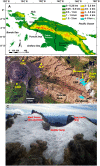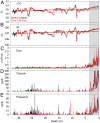Disappearance of the last tropical glaciers in the Western Pacific Warm Pool (Papua, Indonesia) appears imminent
- PMID: 31818944
- PMCID: PMC6936586
- DOI: 10.1073/pnas.1822037116
Disappearance of the last tropical glaciers in the Western Pacific Warm Pool (Papua, Indonesia) appears imminent
Abstract
The glaciers near Puncak Jaya in Papua, Indonesia, the highest peak between the Himalayas and the Andes, are the last remaining tropical glaciers in the West Pacific Warm Pool (WPWP). Here, we report the recent, rapid retreat of the glaciers near Puncak Jaya by quantifying the loss of ice coverage and reduction of ice thickness over the last 8 y. Photographs and measurements of a 30-m accumulation stake anchored to bedrock on the summit of one of these glaciers document a rapid pace in the loss of ice cover and a ∼5.4-fold increase in the thinning rate, which was augmented by the strong 2015-2016 El Niño. At the current rate of ice loss, these glaciers will likely disappear within the next decade. To further understand the mechanisms driving the observed retreat of these glaciers, 2 ∼32-m-long ice cores to bedrock recovered in mid-2010 are used to reconstruct the tropical Pacific climate variability over approximately the past half-century on a quasi-interannual timescale. The ice core oxygen isotopic ratios show a significant positive linear trend since 1964 CE (0.018 ± 0.008‰ per year; P < 0.03) and also suggest that the glaciers' retreat is augmented by El Niño-Southern Oscillation processes, such as convection and warming of the atmosphere and sea surface. These Papua glaciers provide the only tropical records of ice core-derived climate variability for the WPWP.
Keywords: ENSO; Papua Indonesia; climate change; glacier retreat; tropical ice cores.
Conflict of interest statement
The authors declare no competing interest.
Figures






References
-
- Thompson L. G., Mosley-Thompson E., Davis M. E., Brecher H. H., Tropical glaciers, recorders and indicators of climate change, are disappearing globally. Ann. Glaciol. 52, 23–34 (2011).
-
- Thompson L. G., et al. , Annually resolved ice core records of tropical climate variability over the past ∼1800 years. Science 340, 945–950 (2013). - PubMed
-
- Vimeux F., et al. , Climate variability during the last 1000 years inferred from Andean ice cores: A review of methodology and recent results. Palaeogeogr. Palaeoclimatol. Palaeoecol. 281, 229–241 (2009).
-
- Taylor R. G., et al. , Recent glacial recession in the Rwenzori Mountains of East Africa due to rising air temperature. Geophys. Res. Lett. 33, L10402 (2006).
-
- Thompson L. G., et al. , Kilimanjaro ice core records: Evidence of Holocene climate change in tropical Africa. Science 298, 589–593 (2002). - PubMed
LinkOut - more resources
Full Text Sources
Miscellaneous

